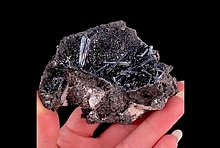Home PageAbout MindatThe Mindat ManualHistory of MindatCopyright StatusWho We AreContact UsAdvertise on Mindat
Donate to MindatCorporate SponsorshipSponsor a PageSponsored PagesMindat AdvertisersAdvertise on Mindat
Learning CenterWhat is a mineral?The most common minerals on earthInformation for EducatorsMindat ArticlesThe ElementsThe Rock H. Currier Digital LibraryGeologic Time
Minerals by PropertiesMinerals by ChemistryAdvanced Locality SearchRandom MineralRandom LocalitySearch by minIDLocalities Near MeSearch ArticlesSearch GlossaryMore Search Options
The Mindat ManualAdd a New PhotoRate PhotosLocality Edit ReportCoordinate Completion ReportAdd Glossary Item
Mining CompaniesStatisticsUsersMineral MuseumsClubs & OrganizationsMineral Shows & EventsThe Mindat DirectoryDevice SettingsThe Mineral Quiz
Photo SearchPhoto GalleriesSearch by ColorNew Photos TodayNew Photos YesterdayMembers' Photo GalleriesPast Photo of the Day GalleryPhotography
╳Discussions
💬 Home🔎 Search📅 LatestGroups
EducationOpen discussion area.Fakes & FraudsOpen discussion area.Field CollectingOpen discussion area.FossilsOpen discussion area.Gems and GemologyOpen discussion area.GeneralOpen discussion area.How to ContributeOpen discussion area.Identity HelpOpen discussion area.Improving Mindat.orgOpen discussion area.LocalitiesOpen discussion area.Lost and Stolen SpecimensOpen discussion area.MarketplaceOpen discussion area.MeteoritesOpen discussion area.Mindat ProductsOpen discussion area.Mineral ExchangesOpen discussion area.Mineral PhotographyOpen discussion area.Mineral ShowsOpen discussion area.Mineralogical ClassificationOpen discussion area.Mineralogy CourseOpen discussion area.MineralsOpen discussion area.Minerals and MuseumsOpen discussion area.PhotosOpen discussion area.Techniques for CollectorsOpen discussion area.The Rock H. Currier Digital LibraryOpen discussion area.UV MineralsOpen discussion area.Recent Images in Discussions
Mineralogical ClassificationIMA 2013-009 = engelhauptite
20th Nov 2015 09:04 UTCMarco E. Ciriotti Manager
▪ Pekov, I.V., Siidra, O.I., Chukanov, N.V., Yapaskurt, V.O., Britvin, S.N., Krivovichev, S.V., Schüller, W., Ternes, B. (2015): Engelhauptite, KCu3(V2O7)(OH)2 Cl, a new mineral species from Eifel, Germany. Mineralogy and Petrology, 109, 705-711.
Abstract:
A new mineral engelhauptite, KCu3(V2O7)(OH)2Cl, was found within cavities in nepheline basalts at the Auf’m Kopp quarry (“Schlackenkegel der Höhe 636 südöstlich Neroth”), Daun, Eifel region, Rheinland-Pfalz, Germany. Associated minerals are volborthite, allophane, malachite, tangeite and chrysocolla; earlier minerals belonging to the primary, high-temperature parageneses are augite, mica of the phlogopite–oxyphlogopite series, sanidine, nepheline, leucite, fluorapatite and magnetite. Engelhauptite occurs as spherulites (up to 0.2 mm in diameter) and bunches consisting of rough spindle-shaped crystals elongated parallel to [0001]. The crystals are up to 0.12 mm long and up to 0.04 mm thick. Individual grains of engelhauptite are transparent, whereas their aggregates are translucent. The mineral is yellow-brown to brown, typically with an olive green hue. The luster is vitreous. Engelhauptite is brittle, cleavage is not observed, fracture is uneven. D calc = 3.86 g cm−3. Engelhauptite is optically uniaxial (+), ω = 1.978(4), ε = 2.021(4). Chemical data (wt.%, electron-microprobe, H2O by difference) are as following: K2O 9.63, FeO 0.05, NiO 0.29, CuO 46.11, Al2O3 0.24, V2O5 34.92, SO3 0.79, Cl 5.94, H2Ocalc 3.37, O = Cl2 -1.34, total 100.00. The empirical formula, based on 10 (O + OH + Cl) apfu, is K1.05(Cu2.97Al0.02Ni0.02)Σ3.01(V1.97S0.05)Σ2.02O7.23(OH)1.91Cl0.86. Engelhauptite is hexagonal, P63/mmc, a = 5.922(2), c = 14.513(5) Å, V = 440.78(3) Å3 and Z = 2. The eight strongest reflections of the powder X-ray diffraction pattern [d,Å(I) (hkl)] are: 7.32(98) (002), 4.224(17) (102), 2.979(100) (104, 110), 2.759(19) (112), 2.565(18) (200), 2.424(18) (202), 1.765(16) (206) and 1.481(14) (208, 220). The crystal structure of engelhauptite has been solved from the single-crystal X-ray diffraction data and refined to R = 0.090 on the basis of 135 unique observed reflections. The structure is based upon the [Cu2+3(V2O7)(OH)2]0 framework formed by the linkage of deficient brucite-like layers of Jahn-Teller distorted Cuφ6 octahedra (φ = O, OH) via divanadate V2O7 groups. The framework contains large channels occupied by K+ cations and Cl− anions. Engelhauptite is closely related to volborthite, Cu3(V2O7)(OH)2∙2H2O, and can be considered as its analogue resulting from the replacement of H2O molecules by the equal amounts of K+ and Cl− ions. The mineral is named in honour of the German amateur mineralogist and mineral collector Bernd Engelhaupt (born 1946).

21st Nov 2015 10:35 UTCKnut Edvard Larsen Manager




Mindat.org is an outreach project of the Hudson Institute of Mineralogy, a 501(c)(3) not-for-profit organization.
Copyright © mindat.org and the Hudson Institute of Mineralogy 1993-2024, except where stated. Most political location boundaries are © OpenStreetMap contributors. Mindat.org relies on the contributions of thousands of members and supporters. Founded in 2000 by Jolyon Ralph.
Privacy Policy - Terms & Conditions - Contact Us / DMCA issues - Report a bug/vulnerability Current server date and time: May 11, 2024 12:52:44
Copyright © mindat.org and the Hudson Institute of Mineralogy 1993-2024, except where stated. Most political location boundaries are © OpenStreetMap contributors. Mindat.org relies on the contributions of thousands of members and supporters. Founded in 2000 by Jolyon Ralph.
Privacy Policy - Terms & Conditions - Contact Us / DMCA issues - Report a bug/vulnerability Current server date and time: May 11, 2024 12:52:44











